It hadn’t been a great start to the Premier League season for Arsenal under the management of Unai Emery as they registered too many draws which hindered their progress during the first stage. The last few days of 2019, the club announced the appointment of their former player Mikel Arteta to the managerial spot and since then, he brought a fresh style of play and amid the slow start, results started to come for the Spaniard and his side.
In his fourth match with Arsenal, the London-based side welcomed fifth-placed Manchester United to their home stadium as they looked for their second win in December across all competitions. For the away side, they started to find the rhythm again with six wins and two draws in all competitions in their last ten matches. As they focused on maintaining a high rate of possession to get the results that they aimed for, they travelled to the Emirates Stadium with high confidence among the squad.
But at the end of the day, Man United were seen out on the opposite side as two goals from Nicolás Pépé and Sokratis Papastathopoulos inside the first half secured the first three points for Arteta at Arsenal. This tactical analysis will provide an analysis of Arsenal’s 2-0 win over Man United. Meanwhile, using statistics, we will point out the noticeable tactical points in Mikel Arteta’s tactics and Ole Gunnar Solskjær’s tactics.
Lineups
Before the match, Arsenal had seen one of their key players in Calum Chambers hobbled off the field in their game against Chelsea. Another full-back who also missed out from the squad list was Kieran Tierney as he remained on the treatment list. In contrast, they welcomed back two crucial defenders in Sokratis Papastathopoulos and Sead Kolašinac and with them completed the back-four that already consisted of centre-back David Luiz and right-back Ainsley Maitland-Niles.
While Granit Xhaka missed out on the Chelsea match as he was recovering from illness, he had returned to training just a few days prior to the Man United game and was included in the starting lineup alongside Lucas Torreira at the heart of the midfield. Up front, Nicolás Pépé and Pierre-Emerick Aubameyang occupied the wide spaces instead of the youngster duo in Reiss Nelson and Gabriel Martinelli.

On the opposite side, Man United still didn’t have the service of Paul Pogba after he made a substitute appearance against Watford with Nemanja Matić and Fred paired up with each other as central midfielders in Solskjær’s 4-2-3-1 system. Two academy products in Axel Tuanzebe and Scott McTominay, though, missed out from the match through different injuries problems.
At the back, Eric Bailly and Timothy Fosu-Mensah were still recovering from their injuries and they were far from returning to the squad. Against Burnley, youngster Brandon Williams and Ashley Young were chosen to occupy the full-backs spot, but Luke Shaw and Aaron Wan-Bissaka returned to the lineup and provided width in the team’s attack. Jesse Lingard also replaced Andreas Pereira as the team’s attacking midfielder as he formed the attacking midfielders’ line with Marcus Rashford and Daniel James.
Arsenal’s style of play
It is evident that there are major changes being implemented when Arteta arrived at Arsenal as a manager. One of the adjustments that can be seen from this match is how confident the players were when they held the ball. They had the tendency of playing out from the back with the involvement of both Luiz and Sokratis. The two centre-backs also formed a passing block along with the two central midfielders as they aimed to progress the ball up the pitch.
Another player who was involved heavily in the build-up stage was right-back Maitland-Niles, which helped the team to create a three-man build-up to link up with Xhaka and Torreira. He tended to stay back more often but would still stick to the right-flank as he aimed to stretch Man United’s press. On the opposite wing, though, Kolašinac tended to overlap high up the pitch to provide an attacking option down the left-hand side. His involvement in the attack allowed Aubameyang to cut inside and work more in the half-space.
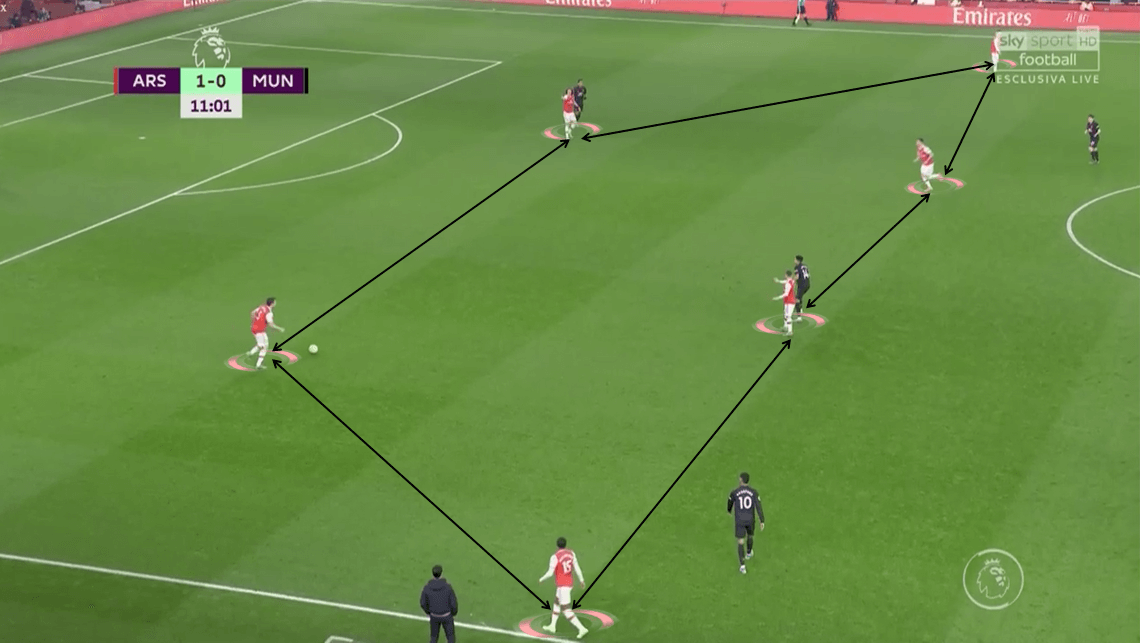
An advantage that can be noticed from this strategy is that the team gained numerical superiority over Man United press. This is one of the reasons that helped the players to have more confidence in controlling possession and play out from the back as they were able to maintain a short support range among each other and create passing triangles among them.
Furthermore, staying close to each other also allowed them to play one-two passes and bypass the press, similar to the shot below. As Rashford and Lingard attempted to recover possession high up the pitch, they were trapped in between two passing triangles that were created by Arsenal players. Using one-two passes, it was viable for the home side to escape the press and progress the ball forward.
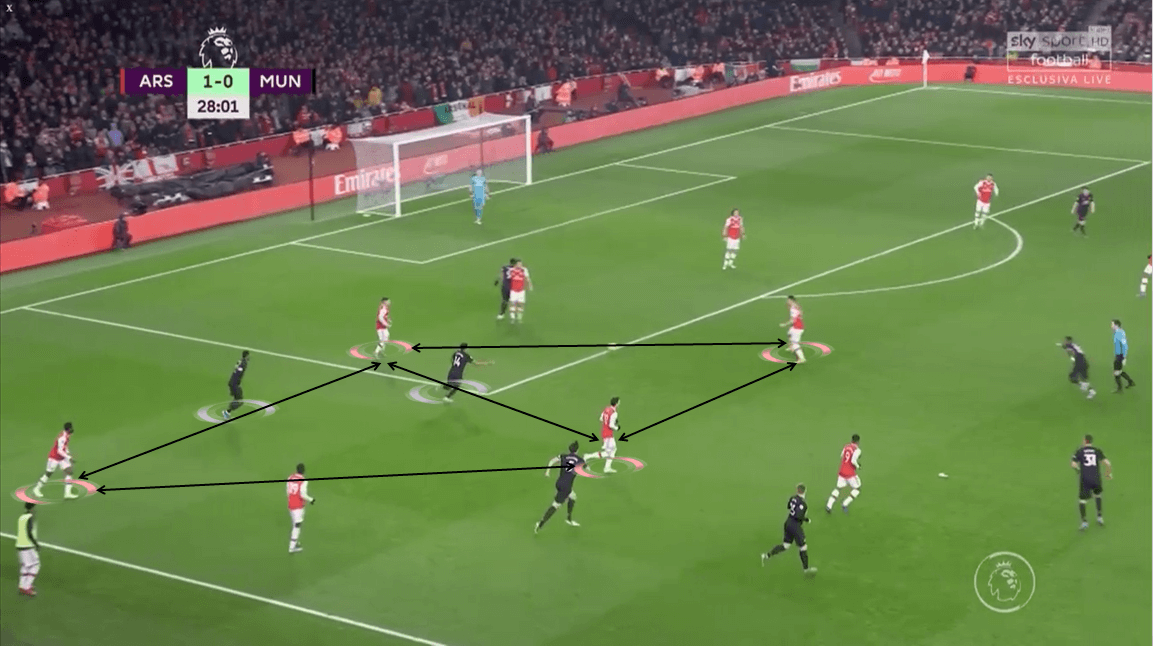
Statistically speaking, though, they shared the possession with Man United as both teams controlled 50% of the ball. It came as a surprise as it felt like the home side were able to keep the ball on more occasions and they were comfortable playing out from the back. Furthermore, their opposition had more pure possession time compared to Arsenal’s since they held the ball a minute more.
Nonetheless, it came down to which team was able to get the ball into the opposition’s half more often and Arsenal were the team who came out on top in that regard. With 18% of their possession reaching the opponent box compared to Man United’s 10%, this contributed to the fact that they were able to have a higher xG rating in 1.92 for their chances.
Still, it is worth taking a look at how they progressed the ball into the opposition’s half and the final third. Firstly, as mentioned, they were a wing-oriented team and focused on distributing the ball down the left-hand side. With Kolašinac overlapping in most occasions, it was possible for Aubameyang to roam from his position more often and even position himself in between the lines.
One thing that’s worth noticig, though, is that Aubameyang’s movement usually pinned down Wan-Bissaka. As he attempted to move forward, this forced the former Crystal Palace defender to drag back in order to prevent him from attacking the space behind Man United’s defensive line. It also opened up a gap on the left-wing which allowed the centre-backs to find Kolašinac and, thus, start an attack for the team.
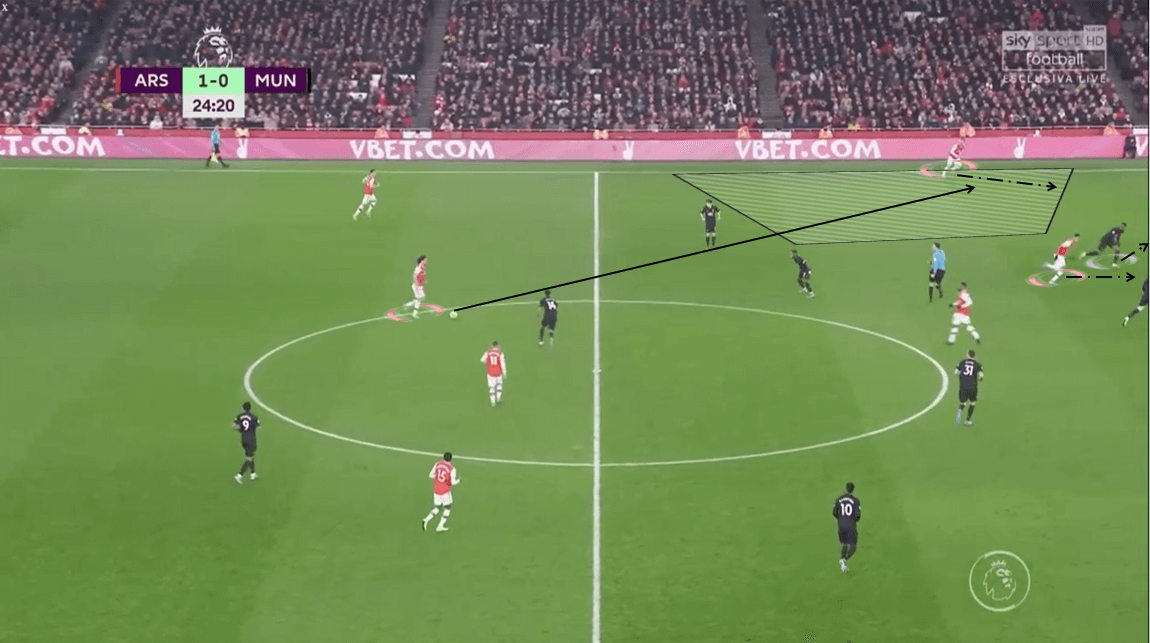
At the same time, intelligent movements also benefitted them in capitalising on space being left unoccupied. In the shot below, notice how the positioning of Pépé and Mesut Özil pinned down Shaw and Rashford. They had to move out of their positions to mark the mentioned Arsenal players, but, at the same time, created space behind them.
This allowed Maitland-Niles to cut inside and enter the gap without being picked out by Matić and even turn up at the end of the German midfielder’s pass. This occurred quite often during the match with Arsenal players positioning themselves high up the pitch and between the defenders to link up with through passes that came from Özil or other midfielders.
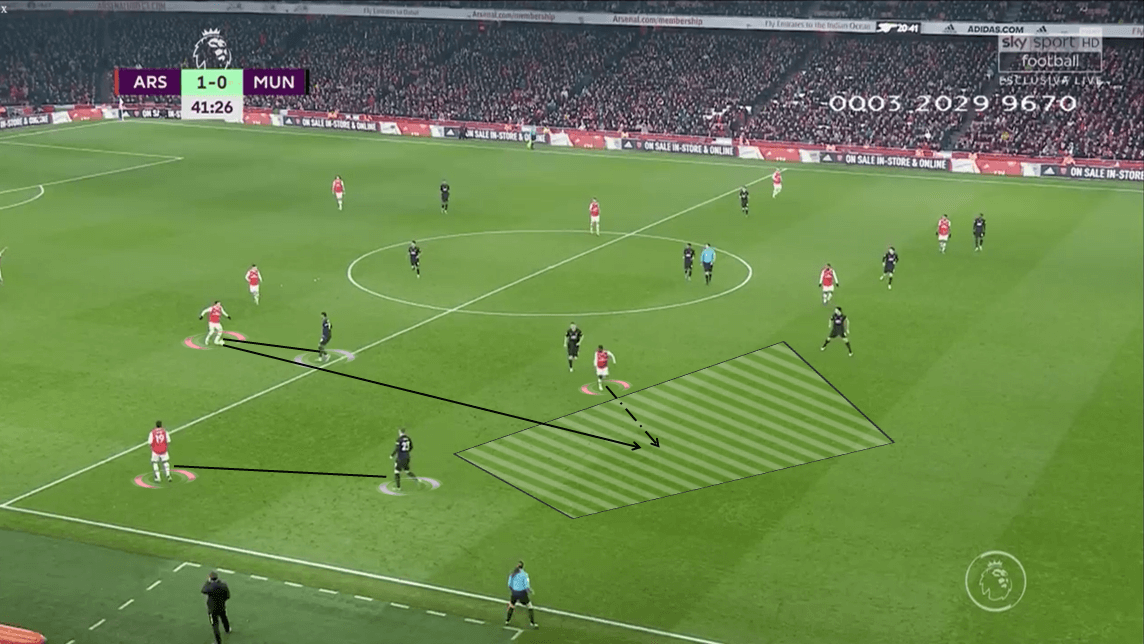
Defensively, Arsenal players aimed to form a 4-4-2/4-4-1-1 defensive shape inside their half. The advantage of having two distinctive defensive lines is to be able to control Man United’s attacks more easily. Also, by stretching the shape a bit wider, the home side were able to occupy the central and the wide halves of the pitch.
With the opposition attempting to attack down the right-hand side, it would make their shifting process easier since the players kept a sufficient distance between themselves. Maitland-Niles and Pépé would become focal points to shift the shape, similar to the shot below. They put pressure on the ball carrier first while waiting for the support from their teammates.
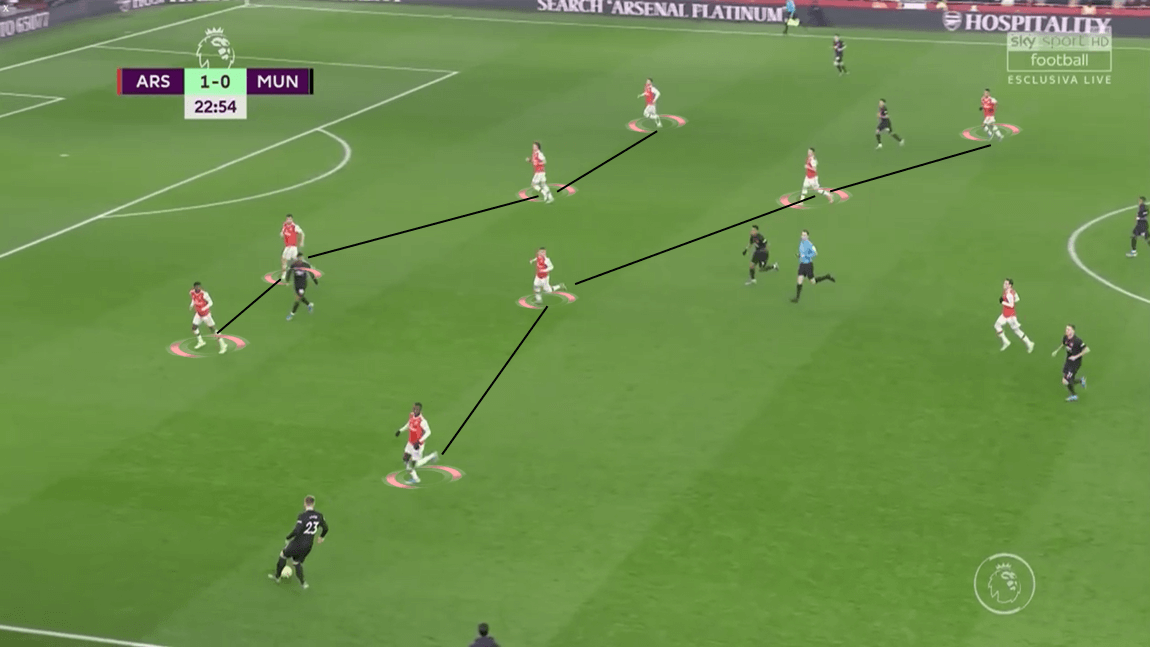
Their defensive shape also allowed them to overload the central half when Man United had the ball. During the match, Man United weren’t able to attack centrally on a constant basis as they lacked passing options in between Arsenal’s defensive line and the home side had many players who were ready to cut down passing lanes and intercept passes.
Amid the fact that they were able to get the ball forward and even into Arsenal’s half, the Man United players found it hard to beat the defensive shape. They were forced to circulate the ball inside the middle third or even attempted to distribute the ball wide for Rashford and James. In the shot below, although the away side had four players occupying both wings, they didn’t have any inside the central half to become an available passing option for Matić and Fred.
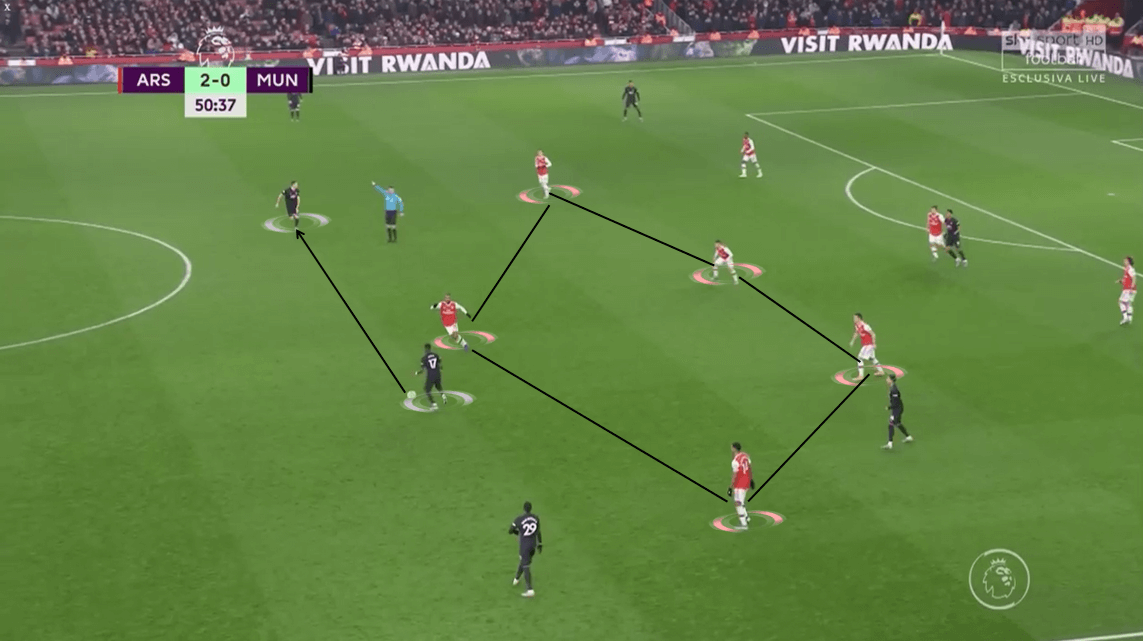
High up the pitch, they aimed to press the opposition’s build-up but opted to stay conservative. Still, a principle that the players took on was minimising the space around the ball carrier by applying pressure on them immediately after they received the ball. The shot below demonstrated perfectly the instruction that Arteta deployed for the players.
As Harry Maguire carried the ball up the pitch, Özil immediately approached the English centre-back and limited the space that he had. But while he was able to pass the ball before Özil arrived, the target now changed to Matić as Torreira approached and applied pressure on the Serbian midfielder. This forced him to make a back pass, which led to the team losing possession later on.
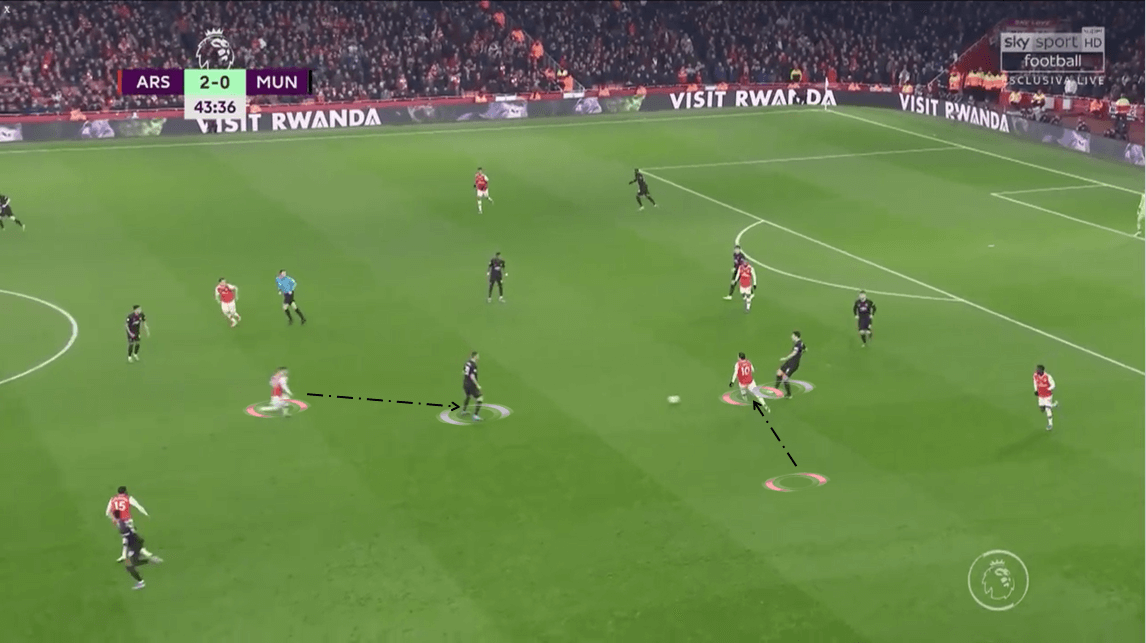
As mentioned, though, their press high up the pitch remained conservative and it resulted in the players not registering too many duels and recoveries inside the final third. But, instead, the players worked hard inside their half, or more specifically, their defensive third to recover possession. With 57% and 73% of their duels took place inside the first half and second half respectively, it was the highest numbers of duels registered.
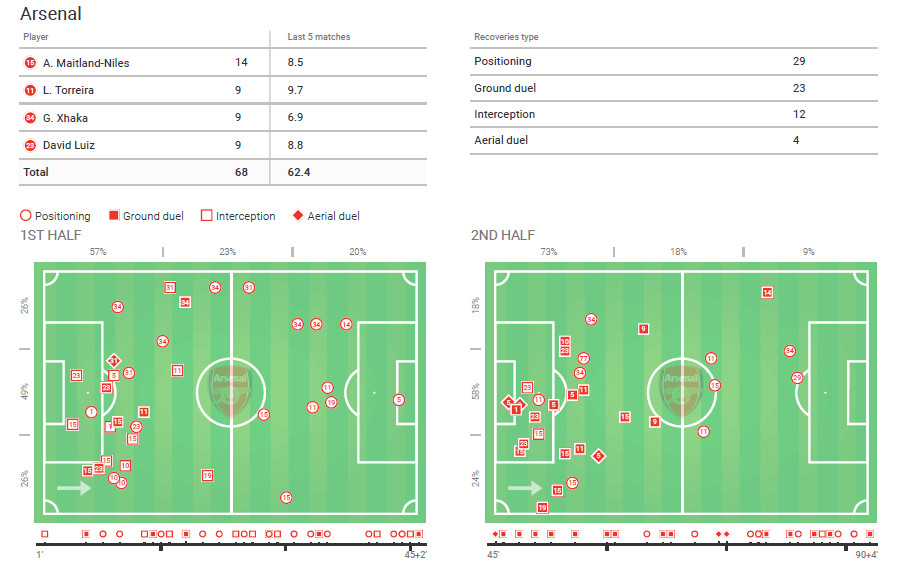
Man United’s style of play
It is clear that Man United’s possession stats for this game were not too bad at all, given that they shared possession with the home side. The last few matches against Newcastle and Burnley, a similar thing happened with Solskjær’s side with them controlling the ball more often and even outplaying their opponents. Many fans would expect them to end the match in a similar outcome to the last two matches, but it was not the day for the Red Devils.
As shown in their passing network below, the players weris that e able to create many links between each other, especially the defenders. They played out from the back quite often with the involvement of Harry Maguire and Victor Lindelöf. On the left side, Shaw also took on an important role in progressing the ball forward. Similar to Arsenal, they also relied on both central midfielders as they were the links to help bring the ball out of defence.
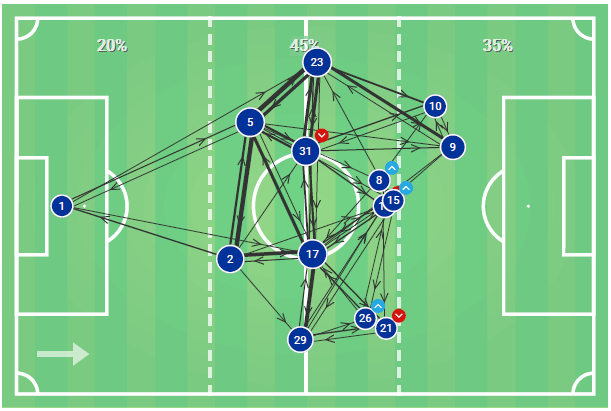
Another thing to note about the team’s build-up, though, they usually faced pressure from Arsenal players which threatened to snatch the ball inside their defensive third. One of the situations, as shown below, demonstrated how the home side pressed and attempted to cut the passing lanes of Man United players.
Firstly, it is worth noticing that the away side had numerical superiority in this situation, with them having six players who were ready to receive the ball and bring it out of defence. Still, the positioning of the Arsenal players caught the attention as they were on hand to mark the nearest passing options to David de Gea and forced the Spanish goalkeeper to go long. Alexandre Lacazette led the line as he limited the space around De Gea as he opted to lay the ball towards Maguire.
Immediately, Özil suffocated him by heading close to the former Leicester player alongside Lacazette. At the same time, Xhaka was already able to mark Fred, which eliminated another possible passing option. They eventually lost the ball later on but were able to recover possession, still, it was a situation that showed the struggling build-up phase against a conservative, but intelligent press from the home side.
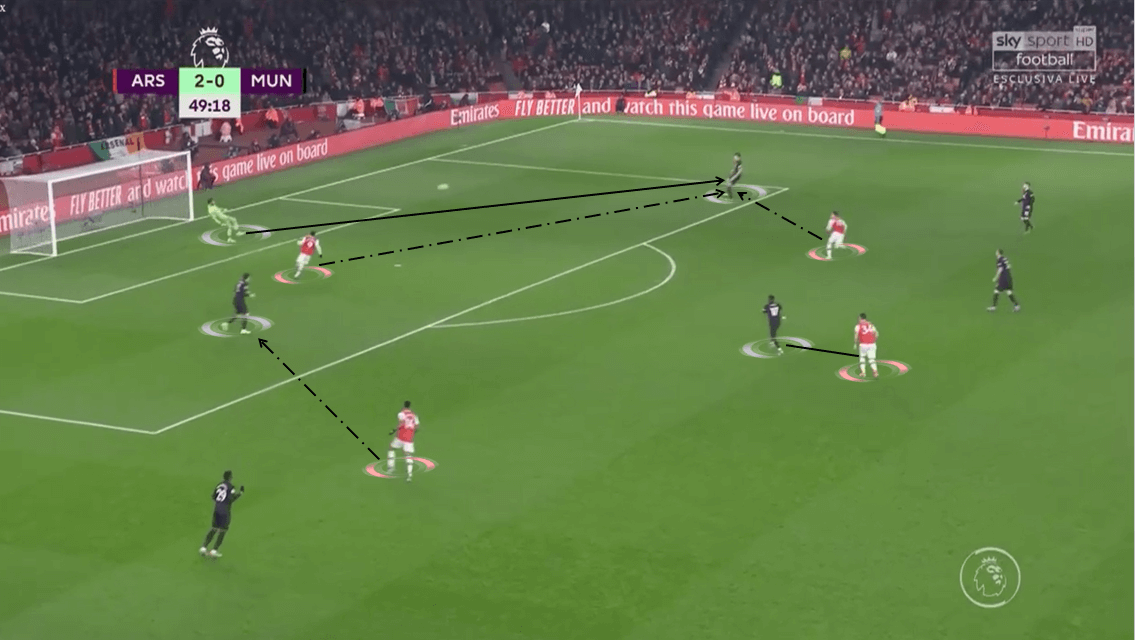
But against a stubborn defensive line of Arsenal, as mentioned, the attackers struggled to get the ball into the final third and create high-quality chances. One of the methods that the Manchester-based side attempted to deploy in order to get the ball into the box was passing the ball in between the lines. Keeping the support range as narrow as possible was the main principle in order not to lose the ball while being able to connect with their teammates. By making one-two passes in between each other, they were able to move the ball in quick fashion.
Still, it was not enough to help them in terms of getting close to converting the chances into the important goals that Man United needed. While they registered more shots on target compared to Arsenal, the quality of those chances were not too high as their total xG rating only stood at 0.71 xG. Several of those chances that found Bernd Leno’s goal were long shots which did not cause much trouble for the German goalkeeper.
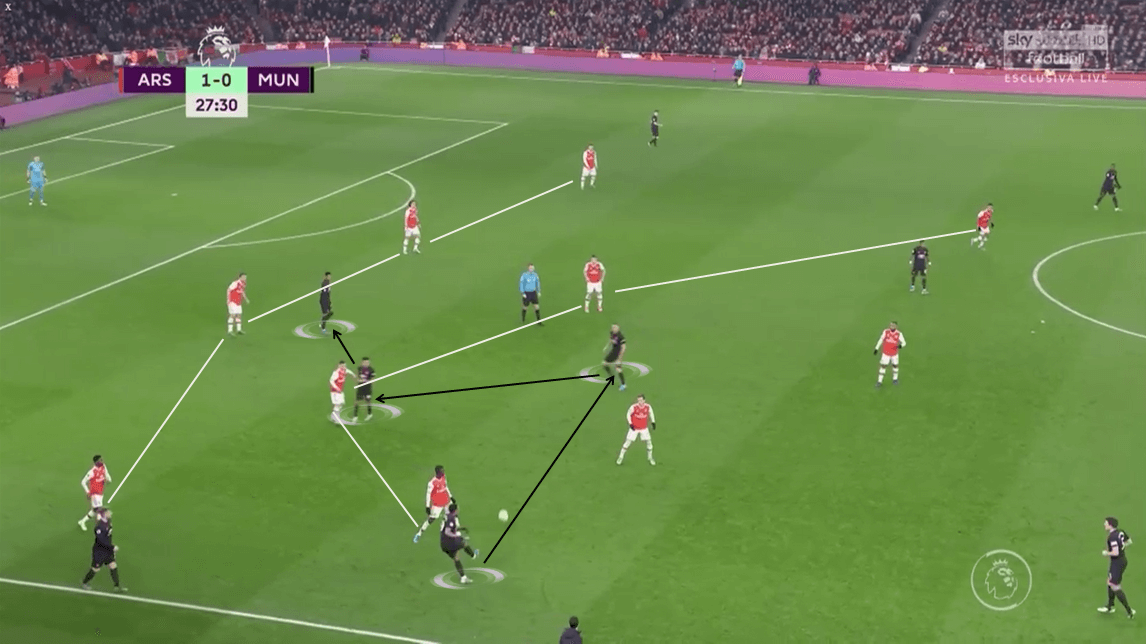
When they were out of possession, Man United also maintained their 4-2-3-1 formation as they attempted to get their press as high up the pitch as possible. Usually, Anthony Martial and the attacking midfielders proved to be the most active players during the press. Given that they usually aimed to create overloads across Arsenal’s half along with the wing-backs, this allowed them to increase pressure on their opponent.
The press proved to be useful on several occasions, especially out wide, since they aimed to use the byline and forced Luiz and Sokratis to make long passes up front. But, again, the ability to keep the ball close to them and a short support range were the two factors that helped Arsenal to bring the ball out of defence on many occasions.
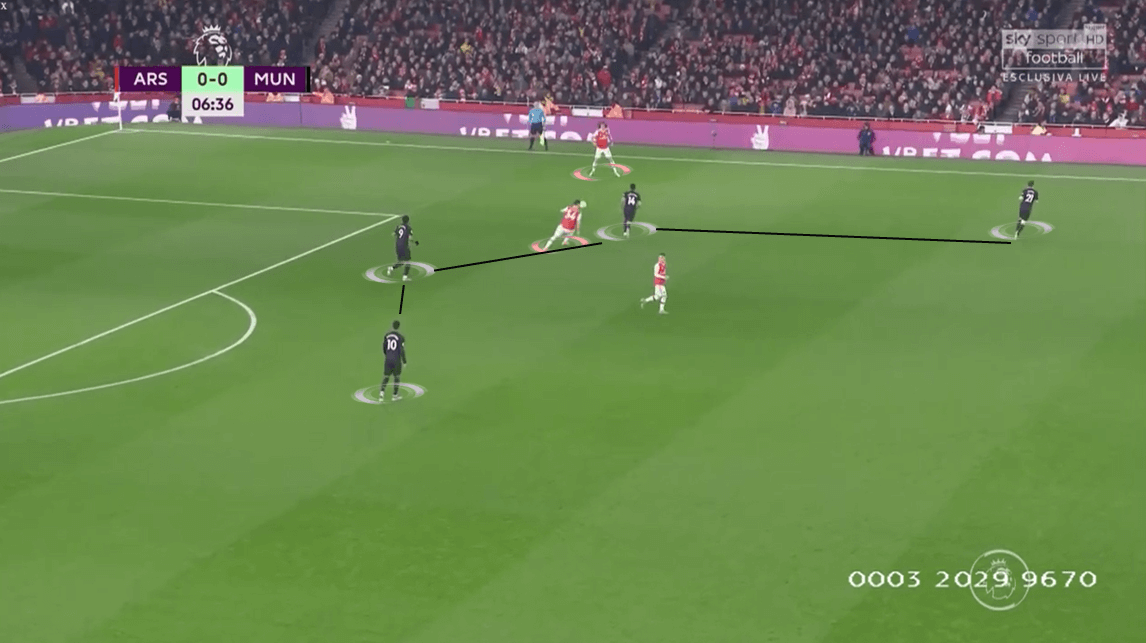
As the press was bypassed, the players would quickly retreat back into their half and formed the defensive shape. But there was one major problem that the away side constantly faced and it cost them the game – their marking ability. The scenario below was just one of the situations that proved to be costly for Man United, but it stood out since it led to Pépé’s opening goal.
While they were able to form the back-four and even received support from the central midfielders, Man United players kept their defensive shape too narrow as they left almost a half of their defensive third unoccupied. This allowed Özil and Pépé to arrive late into the box without any significant pressure being placed on them. Even when Shaw kept his sight on the German midfielder, no one was able to mark Pépé as he were able to receive Kolašinac’s cross to score the first goal of the match.
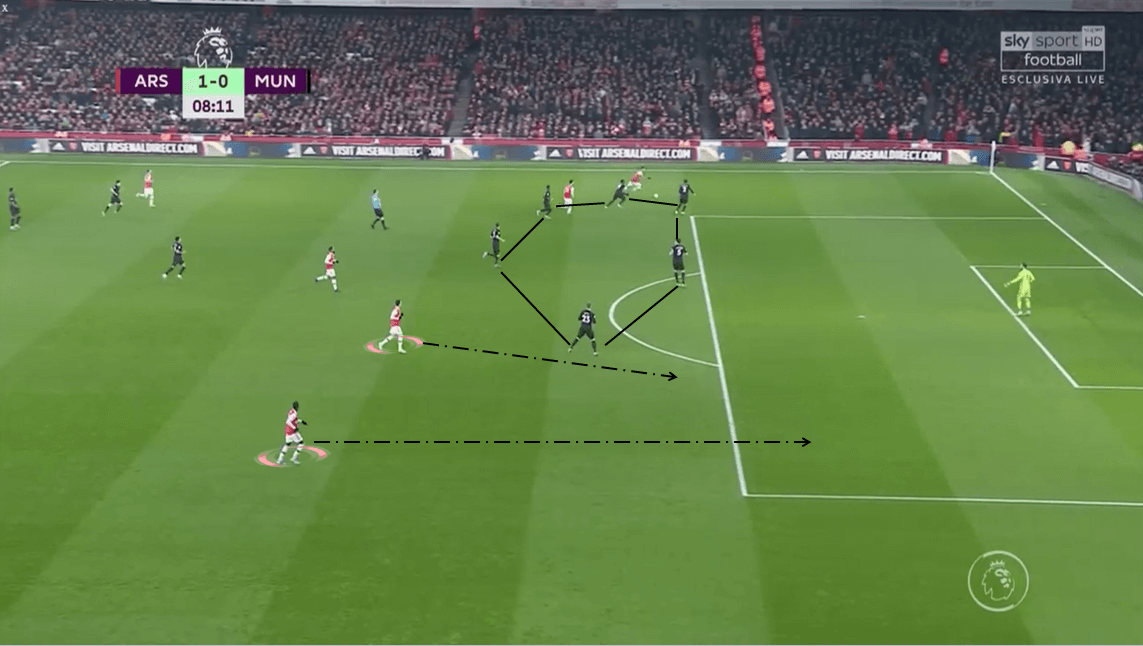
Conclusion
It was worth the wait for the first win for Arteta at Arsenal and it came in a good fashion for the London-based side. His possession-based style of play was compared to Pep Guardiola’s tactics that he is using at Manchester City, but with a few adjustments to it, the former Spanish midfielder was able to deploy a similar version of it for Arsenal while still keeping it fit for the personnel that he has. This first win, though, showed how good his tactics were and it will be the momentum for Arsenal to move forward with some more positive results.
For Manchester United, though, they came out of this match empty-handed but their tactics still showed some positive signs that Solskjær and his players can capitalise on. They proved to be solid when they are in possession but need to find another way to progress the ball into the final third when playing against opposition who deploy a low-block. Their players were reluctant to position themselves in between the lines to receive the passes, which made things harder for Matić or Fred to lay the ball into the final third. Still, it is worth mentioning that Man United still built on what they have had in the last three matches as this tactic should help the team change their fortune.

If you love tactical analysis, then you’ll love the digital magazines from totalfootballanalysis.com – a guaranteed 100+ pages of pure tactical analysis covering topics from the Premier League, Serie A, La Liga, Bundesliga and many, many more. Buy your copy of the December issue for just ₤4.99 here





Comments